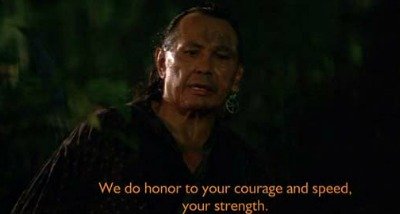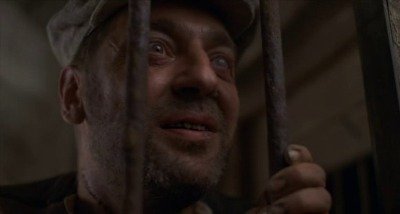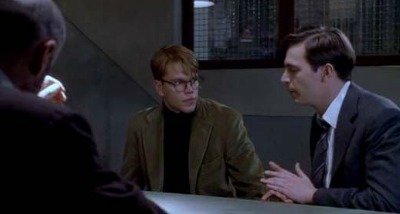No wonder that Formatville's motto is:
"Live by its 10 commandments or" - like Donnie Brasco would say - "Fuhgeddaboudit"
So if you want YOUR screenplay to be read and not tossed, apply these script formatting guidelines. Today the ninth commandment.

We asked our format expert, Matt, aka Formatman, to lead us through the 10 formatting commandments.
If you missed the introduction to this series of articles, you may want to check it out first.
Here is the link to Part 1, where it all started.
Whatascript:
What is this screenplay format commandment about?
Formatman:
Imagine your screenplay characters go abroad or meet other characters who do not speak their language.
How do you:
That's what this screenplay format commandment is about.
Whatascript:
What's the criteria to determine the "default" language of your characters and the foreign one?
Formatman:
In screenplay format the assumption is that you write your screenplay in the language that your reader reads.
In other words, if you submit a screenplay to the US industry, the convention in screenplay format is that the default language spoken by your characters will be American English. Any other language would therefore be foreign.
Whatascript:
Imagine one of my characters speaks a foreign language. How do I show that in terms of screenplay format?
Formatman:
It depends whether it is important to understand what the character says or not.
Formatman:
If your intention is only to create a flavor and
the most common way to do that is to start with the name of the character and follow it with a wrily (= parenthesis) with the language spoken, and the foreign words.
This is an example from "The Talented Mr Ripley", screenplay written by Anthony Minghella.
EXT. MONGIBELLO. LATE DAY. Marge and Ripley are on a shopping expedition. ... They've arrived at the Grocery Store. Alessandra, the woman who owns the store greets them. Silvana, who's her daughter, is also there, and less comfortable. She waits for Marge's order. MARGE (in Italian) Buono Sera, Silvana. Por favore: arance e pane, e del prosciutto. 
In this example it's not important to know that Marge orders oranges, bread and ham.
For that reason, it does not get translated.
In screenplay format, there are often more ways to accomplish the same effect.
This is an example from Hotel Rwanda, screenplay written by Keir Pearson & Terry George.
INT. HOTEL LOBBY. DAY Paul and Tatiana push through the French tourists and AID workers running across the lobby. FRENCH TOURISTS Mon Dieu, Merci.
In this example the screenwriters did not include in a wrily that the language spoken was French, and probably thought it was obvious since they wrote "French Tourists" and basic French words to say "My God, thank you".
Both examples work without any translation, as the pictures of the movie will help understand what is going on and there is no information exchanged that is essential to the plot.
Another famous example to illustrate this point comes from Lost in Translation, screenplay written by Sofia Coppola.
In the "Suntory Time" scene, there are long passages in Japanese, and the translation in English is very short and approximate, which causes a comic effect.
INT. STUDIO - DAY Whiskey commercial shoot. The set is full of activity as the JAPANESE CREW work. Bob, in a shawl collared tuxedo sits at a European style bar set with a cut crystal glass of whiskey. A JAPANESE GIRL quickly powders his face as they adjust lights and the DIRECTOR and crew speak in hurried Japanese. The Director (with blue contact lenses) says a few long sentences in Japanese. TRANSLATOR, a middle-aged woman in a coordinated outfit, translates but it is only a short sentence now. TRANSLATOR He wants you to turn, look in camera and say the lines. Bob wonders what she's leaving out, or if that's the way it works from Japanese to English. BOB That's all he said?
This is the whole scene:

Whatascript:
And what if it matters that the reader understands what the character says in a foreign language?
How do you deal with that situation in terms of screenplay format?
Formatman:
The most frequent option is to use a wrily to indicate that the text gets subtitles on the screen.
This is an example from "The Last of the Mohicans", screenplay written by Michael Mann and Christopher Crowe
As Chingachgook takes out his long knife and they approach the fallen elk ... CHINGACHGOOK (low Mohican; sub-titled) We're sorry to kill you, Brother. Forgive us. We do honor to your courage and speed, your strength ... 
In screenplay format "sub-titled" is often replaced by "with subtitles".
There is also another option.
You state the foreign language and follow it with "English subtitle". This is an example from "The Last of the Mohicans":
MAGUA (in Huron: English subtitle) "Magua understand white man is a dog to his women. When his women want to eat, he lay aside his tomahawk to feed their laziness." Whatascript:
What if you want to indicate that the text gets subtitles but don't want to use a wrily. Is there a way to do that in terms of screenplay format?
Formatman:
Sure. This is from Valkyrie, screenplay written by Christopher McQuarrie & Nathan Alexander
And from out of the blackness a voice. A man speaking in German - faint at first, crackling over the radio. Subtitles translate the voice of Adolf Hitler. HITLER (V.O.) My comrades. Once again - I don't know how many times it has been now - an attempt has been made on my life. I speak to you tonight for two reasons. First, so that you can hear my voice and know that I am unhurt. And second, so that you may know the details of a crime without parallel in German history... Whatascript:
Is there any way NOT to use subtitles and still let the reader know what the characters say?
Formatman:
Yes. In this case the screenplay format would be a mix of foreign language and its translation in English.
This is an example from "Midnight Express", screenplay written by Oliver Stone, with a mix of English and Turkish.
ZIAT (through the bars) You be here tomorrow. "Ayi Gedjaler"("good night") 
Whatascript:
In screenplay format, how do you deal with sign language?
Formatman:
The same way you would with any other language.
This is an example from "Babel", screenplay written by Guillermo Arriaga:
Chieko's team serves. Again, the game is heated. A rival player spikes the ball, and it is barely out of bounds. However, the referee, with his red flag, calls the point. Chieko is upset and goes to argue with him. CHIEKO (In sign language) The ball was out. REFEREE (In sign language) No, it was good.
Then you can continue the conversation without using the wrily every time, as it is obvious the conversation goes on the way it started:
CHIEKO That was out. REFEREE It was on the line.
Whatascript:
What if the character does not speak well the language? How do you indicate that?
Formatman:
You can use a wrily to convey that information.
This is again from "Midnight Express", written by Oliver Stone.
HAMIDOU with his club in hand. HAMIDOU (In some sort of English, smiles) No do. No do.
Whatascript:
What about translation?
Formatman:
Again, there are different ways to take care of that aspect in terms of screenplay format.
This is an example from "The Talented Mr Ripley".
Anthony Minghella chose to first write the lines in Italian, then the translation.
INT. POLICE STATION, INTERVIEW ROOM, VENICE. LATE DAY. This room is not at all friendly. There is evidence of a locked area for cells at one wall. A small, sour window gives onto a canal. The main station is glimpsed through some internal windows. Peter and Ripley come through. Verrecchia sits down. Verrecchia talks in staccato Italian, during which Peter translates. VERRECCHIA Ho assunto io la guida delle indagini in seguito alla negativa valutazione delle disdicevoli circostanze verificatesi con il mio predecessore Roverini che come e noto non e riuscito a impedire il verificarsi della scomparsa del signor Greenleaf, il quale era l'unica persona al momento passibile di incriminazione del reato di omicidio del signor Miles. PETER (translating) He's taken over the case because... they're annoyed the previous chap let Dickie...disappear when he was the only, he was the only suspect in Freddie's murder.

Whatascript:
What if you don't master that foreign language. Can you cut to the chase and write only the English translation?
Formatman:
Yes. That's basically what Christopher McQuarrie & Nathan Alexander did in this example from "The Last of the Mohicans":
A man named HENRI speaks in French. His son, MARTIN, translates. HENRI (O.S. in French) MARTIN (translates) My father says he was driven out of France by the black robe priests and he would fight them now but he lost his arm and so I will go in his place.
Whatascript:
This concludes our interview on this ninth formatting commandment "Thou shalt not lose the reader in translation". Thank you, Formatman.
Formatman:
May the Format be with you!


You may not realize it but by taking this simple action you
empower us to write more articles like that - one Comment/Like/Share at a time.
Thanks for that.
"Thou shalt get one phone call"
Pictures and screenplay extracts:
-- "The Last of the Mohicans", Michael Mann (director), Dante Spinotti (director of photography), Wes Studi (Magua), Christopher McQuarrie & Nathan Alexander (screenplay)
-- "The Talented Mr Ripley", Anthony Minghella (director and screenplay), John Seale (director of photography), Matt Damon (Ripley), Stefania Rocca (Silvana), Gwyneth Paltrow (Marge), Jack Davenport (Peter)
-- "Hotel Rwanda", Keir Pearson & Terry George (screenplay)
-- "Lost in Translation", Sofia Coppola (director and screenplay), Lance Acord (director of photography), Bill Murray (Bob)
-- "Valkyrie", Christopher McQuarrie & Nathan Alexander (screenplay)
-- "Midnight Express", Alan Parker (director), Michael Seresin (director of photography), Paolo Bonacelli (Ziat/Rifki), Oliver Stone (screenplay)
-- "Babel", Guillermo Arriaga (screenplay)
Go from Screenplay Format to Whatascript! Home page
* Inception, screenplay written by Christopher Nolan